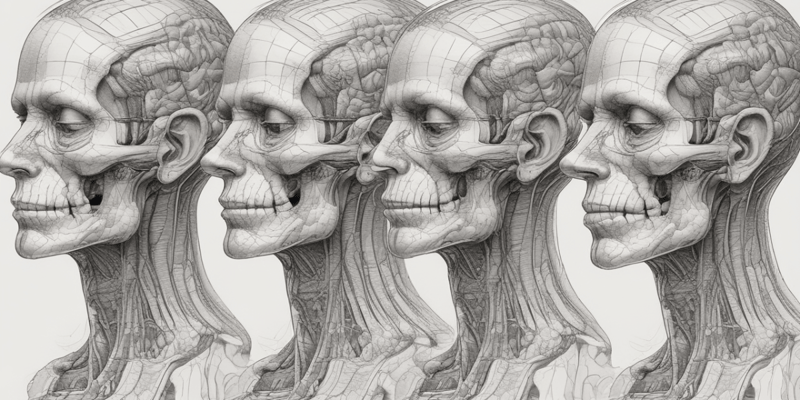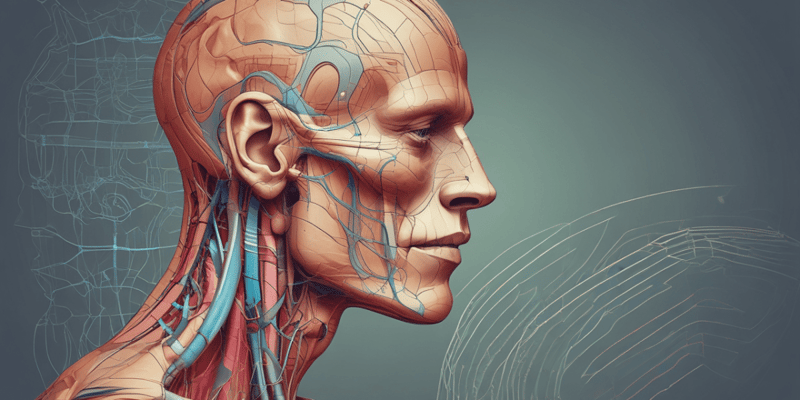Podcast
Questions and Answers
Sound waves entering the ear strike the cochlear duct directly.
Sound waves entering the ear strike the cochlear duct directly.
False
Outer hair cells are responsible for transmitting auditory information to the brain.
Outer hair cells are responsible for transmitting auditory information to the brain.
False
The ossicles of the middle ear vibrate with increased strength and decreased amplitude.
The ossicles of the middle ear vibrate with increased strength and decreased amplitude.
False
Each inner hair cell receives information from 10 separate spiral ganglion cells.
Each inner hair cell receives information from 10 separate spiral ganglion cells.
Signup and view all the answers
Vibrations of the base of the stapes create pressure waves in the perilymph of the scala tympani.
Vibrations of the base of the stapes create pressure waves in the perilymph of the scala tympani.
Signup and view all the answers
Longer waves (low pitch) cause displacement near the oval window.
Longer waves (low pitch) cause displacement near the oval window.
Signup and view all the answers
The organ of Corti is responsible for converting sound waves into a nerve impulse.
The organ of Corti is responsible for converting sound waves into a nerve impulse.
Signup and view all the answers
The lowest tones stimulate inner hair cells located in the basal portion of the cochlea.
The lowest tones stimulate inner hair cells located in the basal portion of the cochlea.
Signup and view all the answers
The movement of the basilar membrane stimulates action potentials conveyed by the cochlear nerve to the brain.
The movement of the basilar membrane stimulates action potentials conveyed by the cochlear nerve to the brain.
Signup and view all the answers
Pressure waves in the perilymph are amplified by the secondary tympanic membrane at the round window.
Pressure waves in the perilymph are amplified by the secondary tympanic membrane at the round window.
Signup and view all the answers
The auditory receptor cells are the outer hair cells.
The auditory receptor cells are the outer hair cells.
Signup and view all the answers
Vibrations are transferred from the scala vestibuli to the scala tympani across the cochlear duct.
Vibrations are transferred from the scala vestibuli to the scala tympani across the cochlear duct.
Signup and view all the answers
The olivocochlear bundle is responsible for innervating inner hair cells.
The olivocochlear bundle is responsible for innervating inner hair cells.
Signup and view all the answers
A sound with a frequency of 300 Hz has a loudness of 100 dB.
A sound with a frequency of 300 Hz has a loudness of 100 dB.
Signup and view all the answers
A unilateral lesion can cause total deafness of the affected ear.
A unilateral lesion can cause total deafness of the affected ear.
Signup and view all the answers
Central unilateral lesions involve lesions in the cochlear nuclei or sound conducting apparatus of the middle ear.
Central unilateral lesions involve lesions in the cochlear nuclei or sound conducting apparatus of the middle ear.
Signup and view all the answers
A central unilateral lesion can result in impaired hearing on both ears.
A central unilateral lesion can result in impaired hearing on both ears.
Signup and view all the answers
The majority of the fibers that make up the auditory pathways do not cross to the other side.
The majority of the fibers that make up the auditory pathways do not cross to the other side.
Signup and view all the answers
The vestibular system is responsible for maintaining body balance and coordination of eye movements.
The vestibular system is responsible for maintaining body balance and coordination of eye movements.
Signup and view all the answers
The vestibular pathway is not essential for maintaining body balance.
The vestibular pathway is not essential for maintaining body balance.
Signup and view all the answers
The dorsal column pathway is not involved in the vestibular system's functions.
The dorsal column pathway is not involved in the vestibular system's functions.
Signup and view all the answers
The vestibular fibers terminate on the auditory cortex.
The vestibular fibers terminate on the auditory cortex.
Signup and view all the answers
Projections of the vestibulorecticular pathway are mainly contralateral.
Projections of the vestibulorecticular pathway are mainly contralateral.
Signup and view all the answers
The Doll's eye test can only be performed on conscious patients.
The Doll's eye test can only be performed on conscious patients.
Signup and view all the answers
In the Doll's eye test, the eyes move in the same direction as the head.
In the Doll's eye test, the eyes move in the same direction as the head.
Signup and view all the answers
The vestibulo-ocular reflex is involved in regulating visceral motor functions such as vomiting and coughing.
The vestibulo-ocular reflex is involved in regulating visceral motor functions such as vomiting and coughing.
Signup and view all the answers
The vestibulorecticular pathway is responsible for regulating cardiovascular functions and respiration.
The vestibulorecticular pathway is responsible for regulating cardiovascular functions and respiration.
Signup and view all the answers
The rocking chair can help to stimulate the vestibulorecticular pathway.
The rocking chair can help to stimulate the vestibulorecticular pathway.
Signup and view all the answers
The ventroposterolateral thalamic nuclei are involved in the vestibulothalamocortical pathway.
The ventroposterolateral thalamic nuclei are involved in the vestibulothalamocortical pathway.
Signup and view all the answers
The vestibular neurons project to the vicinity of the central sulcus near the toe representation.
The vestibular neurons project to the vicinity of the central sulcus near the toe representation.
Signup and view all the answers
The Doll's Head test is used to assess auditory function.
The Doll's Head test is used to assess auditory function.
Signup and view all the answers
The vestibular fibers project to Brodmann Area 4.
The vestibular fibers project to Brodmann Area 4.
Signup and view all the answers
Brodmann Area 7 corresponds to the anterior areas of the parietal lobe.
Brodmann Area 7 corresponds to the anterior areas of the parietal lobe.
Signup and view all the answers
The vestibular pathways are responsible for providing conscious awareness of the position and movements of the hand in space.
The vestibular pathways are responsible for providing conscious awareness of the position and movements of the hand in space.
Signup and view all the answers
The somatosensory areas of the cerebrum include Brodmann Areas 2, 3, and 5.
The somatosensory areas of the cerebrum include Brodmann Areas 2, 3, and 5.
Signup and view all the answers
The vestibular nuclei project to the thalamus via the lateral and inferior vestibular nuclei.
The vestibular nuclei project to the thalamus via the lateral and inferior vestibular nuclei.
Signup and view all the answers
The caloric test is used to assess auditory function.
The caloric test is used to assess auditory function.
Signup and view all the answers
The vestibular fibers project to the vicinity of the central sulcus near the neck representation.
The vestibular fibers project to the vicinity of the central sulcus near the neck representation.
Signup and view all the answers




